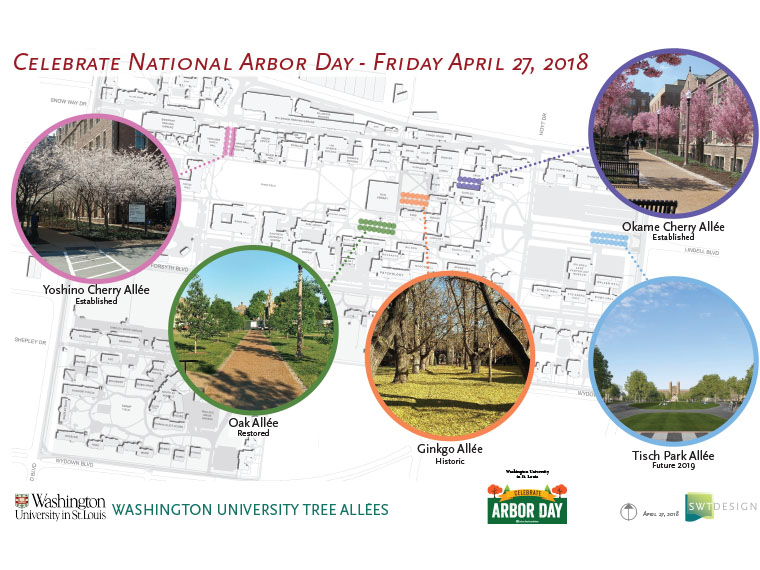 In honor of Arbor Day, Washington University in St. Louis is celebrating its four allées — tree-lined paths that shade walkways, clean our air and make strolling through campus one of the great joys of working and studying at the university.
In honor of Arbor Day, Washington University in St. Louis is celebrating its four allées — tree-lined paths that shade walkways, clean our air and make strolling through campus one of the great joys of working and studying at the university.
Kent Theiling, grounds and landscape design manager, has installed “Celebrate Arbor Day” signs at the university’s four allées. He encourages observers to notice how the allées change from season to season, year to year.
“All of the allées have special features whether it be flowering in the spring time, fall color, or having native and diverse species,” Theiling said. “Annually, the allées’ structures change with branch and trunk growth. They also change seasonally with characteristics of spring flowers, fall color and winter interest when covered in snow, and they are a living architectural element which frames and highlights our campus buildings.”
The allées are:
 • Yoshino Cherry Allée, between the Knight Center and Anheuser-Busch Hall. Yoshino cherry trees make up 70 percent of the 3,800 cherry trees planted at the National Mall and Memorial Parks in Washington, D.C., and are part of the National Cherry Blossom Festival.
• Yoshino Cherry Allée, between the Knight Center and Anheuser-Busch Hall. Yoshino cherry trees make up 70 percent of the 3,800 cherry trees planted at the National Mall and Memorial Parks in Washington, D.C., and are part of the National Cherry Blossom Festival.
• Okame Cherry Allée, from Lopata Hall east to Rudolph Hall. Okame cherry trees are rarely seen as far north as St. Louis. They are the first of the cherry trees to bloom, revealing their pink blossoms as early as late February.
• Oak Allée, south of Olin Library and Eads Hall. Oak Allée was replanted in 2016 and 2017 with Chinkapin oak trees, which are known for their longevity and lovely foliage. Wildlife, especially campus squirrels, love the trees’ sweet-tasting acorns. Take a live look at the allée.
• Ginkgo Allée, east of Olin Library. The largest trees in this historic allée are 95 years old, almost as old as some university buildings. Like Oak Allée, Ginkgo Allée was part of the original campus plan designed by Cope & Stewardson in the early 1900s.
A new tree allée will be planted in Tisch Park next spring as part of the east end project. This allée will feature multiple species, including overcup oak, Shumard oak, Kentucky coffee tree and American elm.